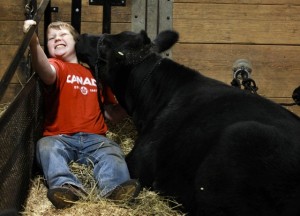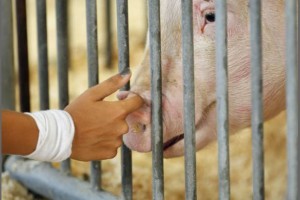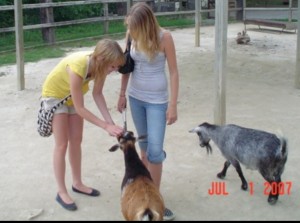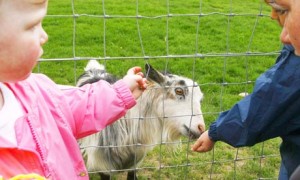With one child dead and 37 now sick from E. coli O157 linked to a North Carolina county fair, the folks who run the NC state fair hope people will wash their hands and mostly avoid touching animals.
This is the best organizers can come up with after two previous North Carolina State Fair  outbreaks – in 2004 and 2011 – sickened over 200 people.
outbreaks – in 2004 and 2011 – sickened over 200 people.
In 2004, 187 people became ill with E. coli O157 after visiting the North Carolina State fair in Raleigh. One of those visitors was a two-year-old who was hospitalized for 36 days with hemolytic uremic syndrome. That led to the passage of Aedin’s Law, which directs the Commissioner of Agriculture to adopt rules establishing sanitation requirements for petting zoos and animal exhibitions.
In 2011, 25 attendees at the same fair acquired E. coli O157 by walking through the Kelley Building where a livestock competition was held. The epidemiology didn’t point to animal contact as a risk factor.
Hope and handwashing is never enough.
At least six of the 37 people sickened in the Cleveland County Fair outbreak in Shelby remained hospitalized Sunday.
Since last year’s outbreak, State Fair organizers have invested more than $200,000 in preventive measures.
Hand-washing stations have better lighting and larger signs. Animal exhibits and food vendors are placed farther apart. Most noticeably, new routes and barriers in animal buildings limit contact between humans and animals.
Kevin White said his family has not gotten sick in 12 years of visiting the livestock and animal exhibits at the fair.
“That’s probably the main point of our adventure out,” White said.
And that’s a common thread in most risk management failures: nothing went wrong last 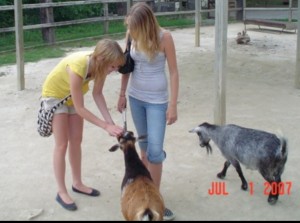 time, so something probably won’t go wrong this time.
time, so something probably won’t go wrong this time.
Go hang out at petting zoos or the exhibits at county and state fairs and watch what little kids do; we have. So have others.
As Anderson and Weese found in 2011 at a temporary petting zoo in Guelph using video observation, 58 per cent of visitors performed some form of hand hygiene (either using water, soap and water, or hand sanitizer), and two interventions (improved signage while offering hand sanitizer, and verbal hand hygiene reminders by venue staff) were associated with increased hand hygiene compliance. U.K. health officials currently recommend handwashing stations with soap and water only (no wipes or sanitizers).
And while some studies suggest inadequate handwashing facilities may have contributed to enteric disease outbreaks or washing hands was protective against illness, others suggest relevant infectious agents may be aerosolized and inhaled. Handwashing tool selection may also contribute to the success of hand hygiene as a preventive measure, as some outbreak investigations have reported alcohol-based hand sanitizer was not protective against illness, especially when hands are soiled.
In the fall of 2009, an E. coli O157:H7 outbreak at Godstone Petting Farm in the U.K resulted in 93 illnesses – primarily little kids.
The investigation into the Godstone outbreak identified evidence of environmental contamination outside the main barn, indicating acquisition of illness through both direct animal or fecal contact, and indirect environmental contact (e.g. contacting railings or soiled footwear).
Aerosolization of potential pathogens is also possible, as suggested in an E. coli O157:H7 outbreak at a county fair in Oregon, in which 60 people fell ill.
As part of the response to the Godstone outbreak, U.K. health types recommended handwashing stations with soap and water only (no wipes or sanitizers, because they don’t work that well under certain conditions).
Ihekweazu et al. subsequently concluded that in the Godstone outbreak, “handwashing conferred no demonstrable protective effect. …
“Moreover, from the findings of many previous published studies, it must be assumed that all petting or open farms are potentially high-risk environments for the acquisition of VTEC O157 infection.”
A table of petting zoo outbreaks is available at http://bites.ksu.edu/petting-zoos-outbreaks.
Erdozain G, Kukanich K, Chapman B, Powell D. 2012. Observation of public health risk behaviours, risk communication and hand hygiene at Kansas and Missouri petting zoos – 2010-2011. Zoonoses Public Health. 2012 Jul 30. doi: 10.1111/j.1863-2378.2012.01531.x. [Epub ahead of print]
Abstract below:
Observation of public health risk behaviors, risk communication and hand hygiene at Kansas and Missouri petting zoos – 2010-2011Outbreaks of human illness have been linked to visiting settings with animal contact throughout developed countries. This paper 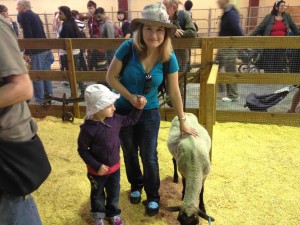 details an observational study of hand hygiene tool availability and recommendations; frequency of risky behavior; and, handwashing attempts by visitors in Kansas (9) and Missouri (4), U.S., petting zoos. Handwashing signs and hand hygiene stations were available at the exit of animal-contact areas in 10/13 and 8/13 petting zoos respectively. Risky behaviors were observed being performed at all petting zoos by at least one visitor. Frequently observed behaviors were: children (10/13 petting zoos) and adults (9/13 petting zoos) touching hands to face within animal-contact areas; animals licking children’s and adults’ hands (7/13 and 4/13 petting zoos, respectively); and children and adults drinking within animal-contact areas (5/13 petting zoos each). Of 574 visitors observed for hand hygiene when exiting animal-contact areas, 37% (n=214) of individuals attempted some type of hand hygiene, with male adults, female adults, and children attempting at similar rates (32%, 40%, and 37% respectively). Visitors were 4.8x more likely to wash their hands when a staff member was present within or at the exit to the animal-contact area (136/231, 59%) than when no staff member was present (78/343, 23%; p<0.001, OR=4.863, 95% C.I.=3.380-6.998). Visitors at zoos with a fence as a partial barrier to human-animal contact were 2.3x more likely to wash their hands (188/460, 40.9%) than visitors allowed to enter the animals’ yard for contact (26/114, 22.8%; p<0.001, OR= 2.339, 95% CI= 1.454-3.763). Inconsistencies existed in tool availability, signage, and supervision of animal-contact. Risk communication was poor, with few petting zoos outlining risks associated with animal-contact, or providing recommendations for precautions to be taken to reduce these risks.
details an observational study of hand hygiene tool availability and recommendations; frequency of risky behavior; and, handwashing attempts by visitors in Kansas (9) and Missouri (4), U.S., petting zoos. Handwashing signs and hand hygiene stations were available at the exit of animal-contact areas in 10/13 and 8/13 petting zoos respectively. Risky behaviors were observed being performed at all petting zoos by at least one visitor. Frequently observed behaviors were: children (10/13 petting zoos) and adults (9/13 petting zoos) touching hands to face within animal-contact areas; animals licking children’s and adults’ hands (7/13 and 4/13 petting zoos, respectively); and children and adults drinking within animal-contact areas (5/13 petting zoos each). Of 574 visitors observed for hand hygiene when exiting animal-contact areas, 37% (n=214) of individuals attempted some type of hand hygiene, with male adults, female adults, and children attempting at similar rates (32%, 40%, and 37% respectively). Visitors were 4.8x more likely to wash their hands when a staff member was present within or at the exit to the animal-contact area (136/231, 59%) than when no staff member was present (78/343, 23%; p<0.001, OR=4.863, 95% C.I.=3.380-6.998). Visitors at zoos with a fence as a partial barrier to human-animal contact were 2.3x more likely to wash their hands (188/460, 40.9%) than visitors allowed to enter the animals’ yard for contact (26/114, 22.8%; p<0.001, OR= 2.339, 95% CI= 1.454-3.763). Inconsistencies existed in tool availability, signage, and supervision of animal-contact. Risk communication was poor, with few petting zoos outlining risks associated with animal-contact, or providing recommendations for precautions to be taken to reduce these risks.
 After a number of Johnson County Fair participants fell ill with stomach cramps and diarrhea, the Department of Health requested stool samples from five people and was able to confirm that all five were suffering from the same type of salmonella.
After a number of Johnson County Fair participants fell ill with stomach cramps and diarrhea, the Department of Health requested stool samples from five people and was able to confirm that all five were suffering from the same type of salmonella.


